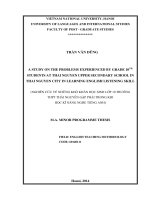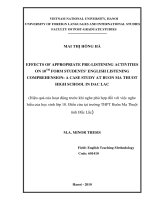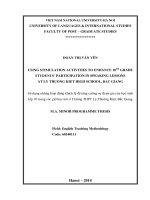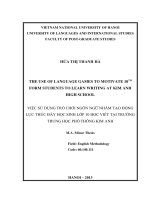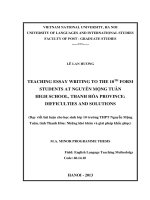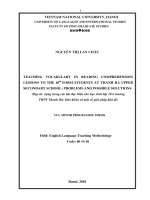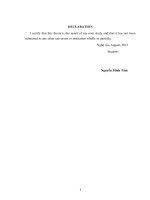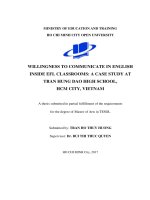Using stimulating activities to improve 10th form students english speaking skill a case study at thuan an upper secondary school in thua thien hue
Bạn đang xem bản rút gọn của tài liệu. Xem và tải ngay bản đầy đủ của tài liệu tại đây (1.48 MB, 119 trang )
-1-
VIETNAM NATIONAL UNIVERSITY, HANOI
UNIVERSITY OF LANGUAGES AND INTERNATIONAL STUDIES
FACULTY OF POST- GRADUATE STUDIES
ĐỖ THỊ THANH BÌNH
TH
USING STIMULATING ACTIVITIES TO IMPROVE 10 FORM STUDENTS’
ENGLISH SPEAKING SKILLS: A CASE STUDY AT THUAN AN UPPER
SECONDARY SCHOOL IN THUA THIEN HUE
( Sử dụng những hoạt động khích lệ để nâng cao kỹ năng nói tiếng Anh cho học sinh
lớp 10: Một nghiên cứu điển hình tại Trường THPT Thuận An tỉnh Thừa Thiên Huế)
M.A MINOR THESIS
FIELD: ENGLISH TEACHING METHODOLOGY
Code: 60 14 10
Cohort: MA 17
HANOI ,SEPTEMBER, 2010
-2-
VIETNAM NATIONAL UNIVERSITY, HANOI
UNIVERSITY OF LANGUAGES AND INTERNATIONAL STUDIES
FACULTY OF POST- GRADUATE STUDIES
ĐỖ THỊ THANH BÌNH
TH
USING STIMULATING ACTIVITIES TO IMPROVE 10 FORM STUDENTS’
ENGLISH SPEAKING SKILLS: A CASE STUDY AT THUAN AN UPPER
SECONDARY SCHOOL IN THUA THIEN HUE
( Sử dụng những hoạt động khích lệ để nâng cao kỹ năng nói tiếng Anh cho học sinh
lớp 10: Một nghiên cứu điển hình tại Trường THPT Thuận An tỉnh Thừa Thiên Huế)
M.A MINOR THESIS
FIELD: ENGLISH TEACHING METHODOLOGY
Code: 60 14 10
Supervisor : Prof. Dr. Hoàng Văn Vân
HANOI- 2010
-6-
TABLE OF CONTENTS
DECLARATION
ACKNOWLEDGEMENTS
ABSTRACT
TABLE OF CONTENTS
LIST OF TABLES AND ABBREVIATIONS
PART A: INTRODUCTION
1.
Rationale of the study
2.
Aims of the study
3.
Research questions
4.
Scope of the study
5.
Significance of the study
6.
Research methodology
-7-
7. Design of the study
PART B: DEVELOPMENT
Chapter 1: Theoretical Backgrounds
1.1. General issues
1.1.1. What is ―speaking‖?
1.1.2. What is ―teaching speaking‖?
1.1.3. Factors affecting English speaking abilities
1.1.4. What a successfully speaking learner should do
1.2. Stimulating activities
1.2.1. Definition of stimulating activities
1.2.2. Types of stimulating activities in teaching speaking skills
1.2.2.1. Role play
1.2.2.2. Simulation
1.2.2.3. Drama
-8-
1.2.2.4. Games
1.2.2.5. Short stories
1.2.2.6. Discussion
1.2.2.7. Video
1.2.2.8. Group work
1.2.3. Three most stimulating activities used in speaking class
1.2.3.1. Games
1.2.3.2. Videos/ DVD in language teaching and learning
1.2.3.3. Role play
1.2.4. Prior studies related to teaching speaking
1.3. Summary
th
Chapter 2: The use of stimulating activities to improve 10 form students’
speaking skill at Thuan An USS
-9-
2.1. Current situation of teaching and learning English speaking skills at Thuan An USS
2.1.1. An overview of Thuan An Upper Secondary School
2.1.2. The English teaching and learning situation at Thuan An USS
2.1.2.1. Description of the students at Thuan An USS
2.1.2.2. Description of the teachers at Thuan An USS
2.1.2.3. The syllabus of teaching and learning
2.1.2.4. The English textbook ―Tieng Anh 10‖
2.1.2.5. Classroom facilities
2.2. A research on the use of stimulating activities
2.2.1. Research Methodology
2.2.1.1. Participants of the study
2.2.1.2. Research instruments
2.2.1.2.1. Classroom observations
2.2.1.2.2. Questionnaire
-10-
2.2.1.2.3. Interview
2.2.2. Data collection procedures
2.2.2.1. Stimulating activities
2.2.2.2. Classroom observations through computer
2.2.2.3. Post-survey questionnaires for students
2.2.2.4. Post-observation interviews
2.2.3. Technique for analyzing data
2.3. Summary
Chapter 3: Findings and discussion
3.1. Data analysis
3.1.1. Analyzing result of post-survey questionnaire
3.1.2. Analyzing results of classroom observations
3.1.3. Result of post-observations interviews
-11-
3.2. Discussion
3.2.1. The use of three stimulating activities to intensify students‘ participation
3.2.2. The effectiveness of three stimulating activities used in class
3.2.3. The students‘ response on the use of three stimulating activities
3.3. Summary
PART C: CONCLUSION
1.Summary of the study
2. Recommendations on how to use three stimulating activities in class
2.1. For the student
2.2. For the teacher
2.3. For the administrator
3. Limitations of the study
4. Suggestions for further research
REFERENCES
-12-
APPENDICES
Appendix 1: Post-survey questionnaire
Appendix 2: Post-observation interviews
Appendix 3: Lesson extract 1
Appendix 4: Lesson extract 2
Appendix 5: Transcribe video taped lessons (Unit 12+ Unit 13)
Appendix 6: Lesson plans (Unit 12+ Unit 13)
I
-13-
LIST OF TABLES AND ABBREVIATIONS
TABLES
Table 1, 2, 3, 4: The students‘ attitudes towards the proposed stimulating activities
Table 4, 5: The effectiveness of the stimulating activities used in 10A class
ABBREVIATIONS
MOET: Ministry of Education and Training
CLT: Communicative Language Teaching
EFL: English Foreign Language
USS: Upper Secondary School
R: Researcher
Ss: Students
St: Student
-14-
PART A: INTRODUCTION
1. Rationale of the study
1.1. Background of the study
After the historic upheaval, Vietnam‘s economy, politics and culture have been
undergone extensive changes. Thanks to the open-door policy, Vietnam has diplomatic
relationship with countries all over the world. English becomes an indispensable means of
communication with the rest of the world.
It can be said that English is the most important international language because it
provides ready access to the world scholarship and world trade. Since then English has
become a compulsory subject in Vietnamese curriculum, its teaching and learning have been
paid much attention.
The aims of foreign language instruction, especially English language instruction, is
commonly defined in terms of four essential skills, reading, writing, listening, and speaking,
of which speaking is becoming the most important aspect in developing one‘s
communicative competence (Moore, 1992: 9).
However, in reality, the teaching and learning of English in Vietnamese high schools
has encountered many difficulties in language proficiency, in speaking skills in particular.
In 2006, a survey questionnaire was conducted in an upper secondary school in Ho
Chi Minh City by Kim Lien with the title ―Why can‘t students speak English after seven
th
years learning at high school?‖ In this survey, 86.6% of two hundred 12 graders believed
that they did not have the ability or the self-confidence to communicate in English. There
were many reasons for this but the most important one was the students‘ motivations and
attitudes. However, the survey pointed out that textbooks had contributed to the difficulties
experienced when learning English. At that time, they used the old series published in the
1980s. The out-of-date information made teachers and students bored with teaching and
learning. In addition, the new policy of examinations focusing only on reading skills through
the multiple-choice format discouraged students from paying much attention to speaking
skills. 52.1% of students in the survey said that they had hardly any speaking or listening
lessons and 44.4% of students said that they never had those lessons but practised grammar
exercises and learning vocabulary instead. However, that survey was carried out in 2006,
when the new volume of English textbooks was not applied in high schools.
-15-
In the academic year 2006-2007, the Ministry of Education and Training (MOET)
introduced the new English textbook to high school students throughout the country. In
general, these new textbooks achieved the goal of teaching English through a communicative
approach. Each unit contains four skills: listening, speaking, reading and writing, with
various interesting topics relevant to the age of the students. The new textbooks have many
advantages; however, they have been a challenge to the students. In a recent survey of three
high schools in Son La Province, Bui (2008) discovered a surprising statistic: less than 5% of
students earned good marks, even in the national graduation exams. The main problem was
that the new textbooks were too difficult for them, with a large amount of new vocabulary. In
addition, many topics were remote from their daily lives and backgrounds, and were
therefore difficult for learning English is limited since they have to spend more time doing
chores, such as planting maize, cassava, or gathering firewood.
1.2. Reasons for the study
As a teacher of English at Thuan An Upper Secondary School in Thua Thien Hue, I
also have the same difficulties. I find the new textbooks more effective than the old ones that
were used years ago. However, my teaching seems to encounter a significant problem: the
students do not pay much attention to their speaking skills, they usually keep quiet in
speaking lessons. There may be two reasons for this. One is that the semester and final
examinations only focus on reading skills and the other is that their lack of background
knowledge.
The first reason, which is a basic one for every high school student, is the motivation
for studying. It is undeniable that passing examinations is one of the most important
motivations in studying. However, according to the policy from MOET, the semester and
final examinations only focus on reading skills through the multiple-choice format. The
graduating student often has five other subjects in the examination, therefore they only pay
attention to practising reading skills and grammatical points as well as vocabularies and
structures. Teachers of English themselves take advantage of the little time they have to
provide reading practice and help with solving problems in grammar exercises in order to
achieve the short-term goal of passing the final examination.
The lack of background knowledge is also a basic reason for students having poor
speaking skills. Most students at my school received their primary and secondary education
at Phu Thuan and Phu Hai and a few of students came from Hue City. These are the two
-16-
poorest coastal communes of Phu Vang District, Thua Thien Hue province, so the learning
conditions are very poor and they are deprived of chances to speak English. While most urban
students start learning English in primary schools, my students do not start until secondary
schools and then they learn in difficult conditions. In addition, outside class time, the
communicative environment in English is limited. An annual survey in my school of English
speaking skills for the 10th graders has given a low result: more than 60% of students have
difficulties when answering simple questions about their names, addresses, age or their hobbies.
As a result, they feel scared of speaking English, of making mistakes, and of not conveying their
sentiments to listeners. It indicates that my students have limited vocabulary. They often use
mother tongue. Hence, most of the students are not confident to use English in speaking class.
For instance, when I asks them to come forward to have a conversation with their friends, they
refuse it. They are shy to perform English conversation in front of their friends. Thus, most
speaking classes are monotonous and unsuccessful. Sometimes, in speaking classes, I have to
guide the ideas in Vietnamese, and then help the students translate the ideas into English. In
reality, these classes are the most ineffective ones.
With the above problems, teachers and learners often pay less attention to speaking skills
than to the others. As a result, the aim of the communicative approach, which the authors
have designed in the textbooks, is ineffective. Short-term studying is another consequence of
these attitudes, in which learners will only study for the reading and writing examinations. A
more serious consequence is the unequal knowledge between the urban and rural students.
Having poor English-speaking skills will inhibit the students‘ ability to communicate,
consequently, they will be unable to obtain enough information and knowledge for global
integration.
Against the problems above, some stimulating activities should be used to overcome
them. I am interested in applying these activities to improve the speaking skills of Thuan An
students in English classes based on the syllabus of MOET so that I will conduct the research
entitled ―Using stimulating activities to improve 10th form students‘ English speaking
skills‖. My objective is to find the most effective ways of helping them to overcome the
barrier of low self confidence when studying speaking skills. I want to help them become
familiar with English and to enjoy learning it more and more. Furthermore, training cadres
for coastal areas is the aim of Thuan An Upper Secondary School in Thua Thien Hue
Province, so being good at English will be a gateway leading to opportunities to work with
international projects for developing economics or cultures.
-17-
2. Aims of the study
The aims of the study are:
- To study the use of three stimulating activities: games, video and role play to intensify
students‘ participation in speaking activities at Thuan An Upper Secondary School.
- To suggest some recommendations on how to use three stimulating activities: games,
video, role play to enhance their learners in speaking skills and develop communicative
skills.
-18-
3. Research questions
The study intends to find out the answers to the following questions:
3.1. What are stimulating activities?
3.2. To what extents are they effective?
4. Scope of the study
- The study only focuses on using three stimulating activities: games, video, role play to
improve English speaking skills for 10th form students at Thuan An Upper Secondary
School in Thua Thien Hue.
th
- The reasons for choosing only three activities for 10 form students are as follows:
+ The students are not experiencing final examination pressures;
+ The topics in Tieng Anh 10 are still basic and simple;
+ The students have time to master speaking skills step by step and consider speaking
as an essential skill in an English learning.
5. Significance of the study
5.1. Theoretical significance of the study
Related to this research, it is hoped that this research can be used as a reference
for other researchers who want to conduct a research on students‘ speaking skill using
three stimulating activities: games, video, role play at upper secondary schools level.
The result of the research can be useful for English teacher in the use of three
stimulating activities: games, video, role play to improve the speaking skill.
5.2. Practical significance of the study
There are some benefits for the teacher and the student:
It will provide variations for other teachers in designing teaching English
especially speaking skills for High School Students.
It will help the students to solve their problems in speaking skills.
The writer hopes that this research will benefit both the teaching and learning of
English.
-19-
6. Research methodology
A combination of qualitative and quantitative methods will be used for this research. The
reason for this combination of the two methods is that because I will identify the problems
based on data collected in questionnaires. However, I will also have class observations and
interviews with 10A students of Thuan An Upper Secondary School in Thua Thien Hue
Province.
7. Design of the study
The study is organized around three parts with three chapters:
Part A- Introduction- consists of background of the study, reasons for the study, aims of the
study, research questions, scope of the study, significance of the study, research methodology
and design of the study.
Part B- Development- is divided into three chapters:
Chapter 1 provides a review of related literature, in which the definition of speaking and
teaching speaking, factors affecting English speaking abilities and what a successful
speaking learner should do are examined. It also deals with stimulating activities which
consists of definition, types of stimulating activities, and some items used as stimulating
activities in speaking class as well as previous studies in teaching speaking skills.
th
Chapter 2 presents the use of stimulating activities to improve 10 form students‘ speaking
skills at Thuan An Upper Secondary School. It provides the current situation of teaching and
learning English speaking skills at Thuan An Upper Secondary School and a research on the
use of stimulating activities. It gives research methodology which consists of research
questions and participants of the study. It also gives research instruments, data collection
procedures, technique for analyzing data.
Chapter 3 provides discusses the findings of the study, data analysis and findings through an
analysis of all data collected by means of classroom observations, post-survey questionnaires
and individual interviews. In this chapter, the writer describes the process of teaching
speaking through stimulating activities such as: games, video, role play at Thuan An Upper
Secondary School.
-20-
Part C- Conclusion-summarizes the main points which have been explored in the study, and
made some recommendations on how stimulating activities should be used to improve 10
th
form students. It also discusses the limitations of the study and makes some suggestions for
further research.
-21-
PART B: DEVELOPMENT
CHAPTER 1
THEORETICAL BACKGROUNDS
1.1. General issues
As a way of start, I will first provide the notions of speaking, teaching speaking, factors
affecting English speaking abilities and what a good speaking learner should do. Then I will
reexamine different types of stimulating activities the foreign teacher often uses to teach a
speaking class. Detailed of these contents are presented in the sections that follow:
1.1.1. What is “speaking”?
There are many definitions of speaking. According to Chaney, (1988:13) speaking is
―the process of building and sharing meaning through the use of verbal and non-verbal
symbols, in a variety of contexts‖. According to other researchers such as Brown (1994),
Burn and Joyce (1997), speaking is ―an interactive process of constructing meaning that
involves producing and receiving and processing information‖. In a related study, Bygate
(1987) had a detailed definition which states that ―speaking is the skill by which learners
are most frequently judged and through which they make and lose friends. It is the vehicle
par excellence of social solidarity, social ranking, of professional advancement and of
business. It is also the medium through which much language is learnt‖.
1.1.2. What is “teaching speaking”?
Nunan (2003) considered ―teaching speaking‖ as a way to teach ESL learners to
produce the English speech sounds and sound patterns. It can help learners use word and
sentence stress, intonation patterns and the rhythm of the second language; select appropriate
words and sentences according to the proper social setting, audience, situation and subject
matter. Teaching speaking aims to teach the learners how to organize their thoughts in a
meaningful and logical sequence, how to use the language quickly and confidently with few
unnatural pauses, which is called fluency.
1.1.3. Factors affecting English speaking abilities
There are many factors that influence the success or failure in learning English speaking.
However, the three most important factors are motivation, attitude and learning strategies.
-22-
Motivation is the first important factor affecting a language learner. According to
Gardner (2001), motivation refers to the driving force in any situation. In the socioeducational model, motivation to learn the second language is viewed as requiring three
elements. First, the motivated individual expends effort to learn the language. That is, there
is a persistent and consistent attempt to learn the material by doing homework, by seeking
out opportunities to learn more, by doing extra work and so on. Second, the motivated
individual wants to achieve the goal. Such an individual will express the desire to succeed,
and will strive to achieve success. Third, the motivated individual will enjoy the task of
learning the language. Such an individual will say that it is fun, challenging, and enjoyable,
even though at times enthusiasm may be less than at other times.
Attitude is the second factor which has an influence on the language learning.
Gardner and Lambert (1972) defined attitude as the persistence that a learner has to follow
an object. Language learning attitude has a relationship to motivation. Language learners
who have extrinsic or intrinsic motivation will have the more positive attitude than those
without motivation or who consider language learning a compulsory subject.
Within second or foreign language education, a number of definitions of language
learning strategies have been used by key figures in the field. Early on, Tarone (1983:67)
defined a language learning strategy as ―an attempt to develop linguistic and sociolinguistic
competence in the target language to incorporate these into one‘s interlanguage competence‖.
Rubin (1987:22) later wrote that language learning strategies ―are strategies which
contribute to the development of the language system which the learner constructs and affect
learning directly‖. In their seminal study, O‘Malley and Chamot (1990:1) defined language
learning strategies as ―the special thoughts or behaviours that individuals use to help them
comprehend, learn, or retain new information‖.
1.1.4. What a successful speaking learner should do
A speaker‘s skills and speech habits have an impact on the success of any exchange (Van
Duzer, 1997). Speakers must be able to anticipate and then produce the expected patterns of
specific discourse situations. They must also manage discrete elements such as turn-taking,
rephrasing, providing feedback, or redirecting (Burns& Joyce, 1997). For example, a learner
involved in an exchange with a salesperson must know the usual pattern that such an
interaction follows and access that knowledge as the exchange progresses. The learner must
also choose the correct vocabulary to describe the item sought, rephrase or emphasize words
-23-
to clarify the description if the clerk does not understand, and use appropriate facial
expressions to indicate satisfaction or dissatisfaction with the service. According to Brown
(1994), other skills and knowledge that instruction might address include the following:
Producing the sounds, stress patterns, rhythmic structures, and intonations of the
language;
Using grammar structures accurately;
Assessing characteristics of the target audience, including shared knowledge or
shared points of reference, status and power relations of participants, interest levels,
or differences in perspectives;
Selecting vocabulary that is understandable and appropriate for the audience, the
topic being discussed, and the setting in which the speech act occurs;
Applying strategies to enhance comprehensibility, such as emphasizing key
words, rephrasing, or checking for listener comprehension;
Using gestures or body language; and
Paying attention to the success of the interaction and adjusting components of
speech
such as vocabulary, rate of speech, and complexity of grammar structures to
maximize listener comprehension and involvement.
Teachers should monitor learners‘ speech production to determine what skills and
knowledge they already have and what areas need development.
1.2. Stimulating activities
As an attempt is made to answer the first research question: What are stimulating
activities? We will address the issues related to stimulating speaking activities. Then in
answer, we will examine the concepts of stimulating, stimulating activities. Finally, we will
suggest some requirements for using stimulating activities in language teaching classes.
Otherwise, this chapter will find out the answer for the first research question.
1.2.1. Definition: According to Oxford Advanced Learner‘s Dictionary, ―stimulating‖ is to
―make people feel enthusiastic; full of interesting or exciting ideas‖ (2005:1057). Up to
now, there is no definition of the researchers about ―stimulating activity‖. According to
Jeremy Harmer (2001), students need frequent changes of activities: they need activities that
are exciting and stimulating their curiosity: they need to be involved in something active.
The span of concentration of our students is less. Thus, we have to assign some interesting
activities to draw their attention.
-24-
Hence, ―stimulating activities‖ are: ―Through a variety of fun, interesting and useful
activities which are given by teachers may attract students‘ motivation, participation in the
learning process so as to stimulate students in the classroom communication includes:
games, discussion, music, dramatic stories, role play and the etc‖. In English language
classrooms, by using stimulating activities, the teacher is able to improve the students‘
speaking ability because they are interesting techniques to apply in classroom. The students
become comfortable to speak everything and get opportunity to develop their communicative
competence more freely. In other words, stimulating activities can be considered effective
tools that teachers should benefit from to stimulate their students to raise much more voice in
class. That is the new setting of a modern language classroom where students are the center
of attention in class.
1.2.2. Types of stimulating activities in teaching speaking skills
Rudolph Kampmeier cited by Mc. Connell (1987:1) argues that ―Teaching is a stimulating
activity on the part of those who are service, since it provides the open mind with techniques
and advances to meet the challenges of the student‖.
Thus, a number of classroom techniques such as role play, discussion, communication games
and problem-solving, and using stories are recommended as appropriate to stimulate natural
communication by theorists such as Harmer (2001), Livingstone (1983), Littlewood (1981),
Ladousse (1987), Ur (1981). In order to help students gain success in speaking, there are
many activities to stimulate students talk in speaking class as follows:
1.2.2.1. Role play
According to Stephen D. Hattings (1993:165) based on his observation in the conversation
class, the role play would seem to be the ideal activity in which students could use their
English creatively and it aims to stimulate a conversation situation in which students might
find themselves and give them an opportunity to practice and develop their communication
skill .
1.2.2.2. Simulations
For others, simulations stimulate student (Joan Andorfer, 2008). Burns & Gentry (1998) state
that the teacher must take on some additional responsibilities in role playing/ simulation. In
particular, the teacher must keep learners motivated by stimulating their curiosity and
keeping the material relevant, creating a "tension to learn".
-25-
1.2.2.3. Drama
According to Bang (2008:30) drama-oriented activities are capable of stimulating the
learners' interest in the English classroom by inducing them to invent a scenario, practice its
discourses, and express them both individually and collectively. Stated simply, the activities
encourage both teacher and student for creativity and spontaneity. Through the dramatic
activities learners not only gain an understanding of grammatical structure in a context but
also experience the dynamic, and productive use of the language to influence, control,
entertain, and inform, that is, as if in real communicative circumstances.
1.2.2.4. Games
According to Carrier (1980:6) ―Games stimulate students‘ participation and give them
confidence.‖ This is when students free themselves in order to participate to get the best score
or even to be the best in the class. They usually feel much more confident with their
performance and this makes them learn and practice new structures, learn from their
mistakes, and fulfill the goals of the class, indeed.
1.2.2.5. Short stories
Puji Rahayu (2008) claims that stories can help to stimulate students overall facility of
creativity. They contribute to multicultural awareness, tolerance and familiarity with each
others beliefs. Stories are akin to a magnet for students to be drawn to reading. We can
exploit the stories to get our students to practice the many language skills required for overall
proficiency. The subsequent sections illustrate how this may be done. The aim of using the
stories was not only to develop communicative ability in English, but also to introduce
Islamic values to Indonesian students. Teaching the past tense is very much aided by using
historical stories. Biblical stories can be used with Christian pupils.
1.2.2.6. Discussion
After a content-based lesson, a discussion can be held for various reasons. The students may
aim to arrive at a conclusion, share ideas about an event, or find solutions in their discussion
groups. Before the discussion, it is essential that the purpose of the discussion activity is set
by the teacher. In this way, the discussion points are relevant to this purpose, so that students
do not spend their time chatting with each other about irrelevant things. Hence, İsmail
ÇAKIR (2006) claims that ―Discussion stimulates communication among students, and it
-26-
helps to achieve communicative practice. With this activity students have an opportunity to
develop sharing and co-operative skills‖.
1.2.2.7. Video
It is universally recognized that videos as visual aids have a lot to contribute to the process of
language learning and teaching, combining education and entertainment. Supporters agree
that videos stimulate student interest to acquire the target culture, as well as language (e.g.,
Stempleski, 1992; Tomalin, 1992). Video is supposed to communicate meaning better than
any other media (Tomalin, 1992). Here it will be useful to look at the advantages of video in
language classes from different perspectives.
1.2.2.8. Group work
Grouping activity is also being able to stimulate and persuade the interest of study among
students. Through this activity the involvement of student in class will be increase, learning
in grouping is more affective to stimulate and strike the values such as motivation,
confidence, the interest to study, cooperation and others (Jacobs and Ratmanida, 1996: 102).
1.2.3. Three most stimulating activities used in speaking class
There is a variety of stimulating activities to use in the teaching and learning process. Each
stimulating activity has its own advantages and using the right activities in the right way to
teach, speaking in class can be a lot of fun, raising general learner motivation and making the
English language classroom a fun and dynamic place. In this study, in reality of my teaching
and talking with my students the researcher suggests using some kinds of stimulating
activities to intensify students‘ participation in speaking activities.
1.2.3.1. Games
1.2.3.1.1. Definition
There are many definitions of the word game.
A form of play or sport, especially a competitive one with rules (Pocket Oxford, 1992: 359).
An activity or sport involving skill, knowledge, or chance, in which you followed rules and
try to win against an opponent or to solve a puzzle (Collins Cobuild, 1987: 596).
Moreover, some writers have defined a game as:
-27-
A structure—that— has rules, goals and agreement of players on the surface, and wonderful
hidden processes underneath (Turtledove, 1996: 3).
An activity with rules, a goal and an element of fun (Hadfield, 1990: 5).
An agreeable way of getting a class to use its initiative in English and as it is gently
competitive, it increases motivation. It is also a contrast to periods of intensive study
(Haycraft, 1978: 94).
Thus, the definitions above —dictionaries and authors—have general similarities amongst
them, they coincide principally in three aspects: competition, rules and enjoyment:
Based on the concepts above, definition of game is considered a valuable technique,
which includes three principal elements: competition, rule(s), and enjoyment, which should
be well established by a teaching-learning objective. Any teacher would be able to use games
in order to increase the student‘s motivation towards the English language, at the same time
that students can better develop or improve his/her own abilities of learning.
1.2.3.1.2. Advantages
The use of games in the classroom has many advantages. Carrier (1980: 6) mentions some of
them:
―Games give a variety of tools to facilitate the teaching-learning process‖;
―Games are flexible‖ ;
―Games make the lesson less monotonous‖;
―Games raise the students‘ motivation‖ ;
―Games make students produce language subconsciously‖ ;
―Games stimulate students‘ participation and give them confidence‖ ;
―Games transform the teacher‘s role from that of formal instructor to that of an
organizer or/and moderator of the class‖ ;
―Games can also serve as a testing mechanism‖.
In conclusion, games can be used to give students enjoyment and useful practice in classes.
More importantly, games provide an opportunity for real communication. Games can
increase student-student communication, but reduce the teacher‘s domination of the
-28-
classroom. Playing games also helps students build solidarity between all participants and
applaud each other‘s efforts to win. This can be useful in reducing teacher-student distance.
Hence, game or competition is stimulating activities to students because the more students
enjoy, the more they learn.
1.2.3.2. Videos /DVDs in language teaching and learning
1.2.3.2.1. Videos/ DVDs as a language-visual aids
"English teachers all over the world cry out for materials which can make English come
alive for their students. TV, video, and the newer video-related technologies provide just
such a resource . . ." (Stempleski (1995:48) qtd in Lebedko).
It is universally recognized that videos as visual aids have a lot to contribute to the process
of language learning and teaching, combining education and entertainment. Supporters agree
that videos stimulate student interest to acquire the target culture, as well as language (e.g.
Stempleski, 1992; Tomalin, 1992). Video is supposed to communicate meaning better than
any other media (Tomalin, 1992). Here it will be useful to look at the advantages of video in
language classes from different perspectives.
1.2.3.2.2. The advantages of videos /DVDs in language teaching
Jeremy Harmer (2001:282) claims that video has many advantages:
Seeing language-in-use
Cross-cultural awareness
The power of creation
Motivation
According to Gallacher (undated), there are totally five benefits that video can bring about
when used in classroom. First, students enjoy language learning with video because video
creates an attractive enjoyable learning environment. Second, video is an effective way of
studying body language. Third, students can obtain confidence when they watch a video.
Fourth, video communicates meaning better than other media. Last, video represents a
positive exploitation of technology.
In conclusion, learners are extremely excited about the programs which combine foreign
language learning with entertainment. By listening to English songs, watching films or
